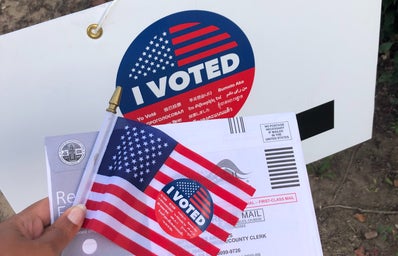This has been a historic year full of unprecedented events, rocking our country continuously. Between a pandemic and a summer full of social unrest, this election year is truly unlike any other. As voters were encouraged to stay at home and vote via mail-in ballot, the voter turnout rate was difficult to predict. Were the safety concerns of flocking to the polls on election day going to be a deterrent? Or were the major changes and detriments in this country going to motivate voters in this election? Well, as the election finally comes to a close and the winner has been announced, voter turnout was astounding.
In this election, we as young people were told our vote was pivotal. This is especially true for us UF students because those that are from Florida or voted on campus, contributed to the Florida electorate. Florida is considered a swing state because the diversity – socio-economically, racially and otherwise – creates some drastic political differences that could swing an election. Sometimes it goes republican and sometimes it goes democrat; this year Florida’s 29 electoral votes went to President Trump. Let’s look at voter turnout in Florida this election and how young people contributed to it.
Youth engagement:
Florida can be a little confusing and voting here at UF can be misleading. Most of northcentral Florida leans conservative, except for Alachua County, where Gainesville is. We are the spot of blue surrounded by a sea of red. This is due to UF being full of college students, most of which vote Democrat. Although they don’t live here permanently, they vote in this county making it overwhelmingly blue. A Pew Research poll puts 59% of Millennial voters as Democrats, and the number is even higher among women at 70%. The numbers on Generation Z’s voting habits are a little less defined, yet as for many of Generation Z, this was their first-time voting.
Young Americans were exceedingly more politically active this election than in the past. In Florida alone out of some 9 million ballots cast in the state, over one million ballots were from people between the ages of 18-29. According to a pollby the Harvard Institute of Politics, when asked how likely they will vote in the 2020 election, 63% of 18-24-year-olds responded that they will “definitely be voting.” That’s on par with the 2008 election and dwarfs the 47% from the 2016 election. 38% responded that they are politically engaged. Altogether, this is unsurprising. The past four years of this presidency has angered and energized the electorate, and as new voters are emerging, they are realizing just how important it is to vote, and how who we vote for does change everyone’s lives.
Just look at how many texts, calls and emails young people have gotten in the past few months leading up to the election. As the election grew closer, I would pick up calls from political parties and campaigns reminding me to vote and instructing me how to vote via mail-in ballot all the time. Although they were annoying at times, they did something, which in turn changed votes.
The United States Elections Project:
UF hires and produces outstanding scholars and individuals. One of whom is Michael McDonald, Ph.D., an associate professor in the political science department studying election methodology and voter turnout. As part of his research, he created the United States Elections Project, a website that compiles voter turnout information and statistics from credible sources and whose goal is to inform the electorate about election results and reliable news outlets. The mission of the United States Elections Project is to, “provide timely and accurate elections statistics, electoral laws, research reports and other useful information.”
Another great source is Dr. McDonald’s Twitter which is hilarious and always up to date on new election information.
Voter turnout rates this close to an election are a little hazy, especially this election due to the extraordinary number of mail-in ballots, so numbers are not yet out. However, the estimates are encouraging.
According to the United States Elections Project, Florida is expected to have a 71.7% voter turnout rate of the eligible voter population, regardless if they are registered or not. That is six points higher than in the 2016 general election and over 15 points higher than in the 2018 midterm elections.
Despite the obstacle COVID-19 placed in discouraging voters from voting in-person, the voter turnout for Alachua County, the state of Florida and the entire country was high.
In Florida alone, over nine million people voted and over a million of those were mail-in ballots.
It’s easy when overwhelming obstacles like a pandemic comes along and dismantles lives to forget to vote or to not think it important because the everyday activities become such a challenge that it seems extra or unimportant. Despite that pull toward apathy, Florida – a critical swing-state with 29 electoral votes – is expected to have a voter-eligible population (VEP) turnout rate higher than it’s been in at least 20 years. That is astounding.
Historically, the United States as a whole has lagged in its voter turnout rates. According to the Pew Research Center, the United States 2016 voting statistics placed us 32nd internationally in voter turnout. But this year is different. The Washington Post is claiming the 2020 election voter turnout is “the highest in over a century.”
This change could precisely be because of the pandemic. Although it limits the amount of in-person voting, mail-in balloting is much more accessible to those that should limit contact with others and for people that can’t get to their voting location, like college students.
Before I was an in-state student, I voted via absentee ballot for the 2018 election for my home state of Delaware. I still vote-by-mail in every election because I want to vote for my home county’s local officials, not Alachua counties.
Because there was an easy option that didn’t even require voters to leave their homes or change out of their sweatpants, people were more likely to vote.
The other possible explanation is that people just cared more about this election. The person in the White House makes policy decisions that affect our everyday lives now so much more than in the past. Every decision on the pandemic directly affects our lives and our safety, so voting is the most we can do as Americans to voice our opinions.
If this election proved anything, it’s that we have a voice and that extraordinary things happen when we use it.


